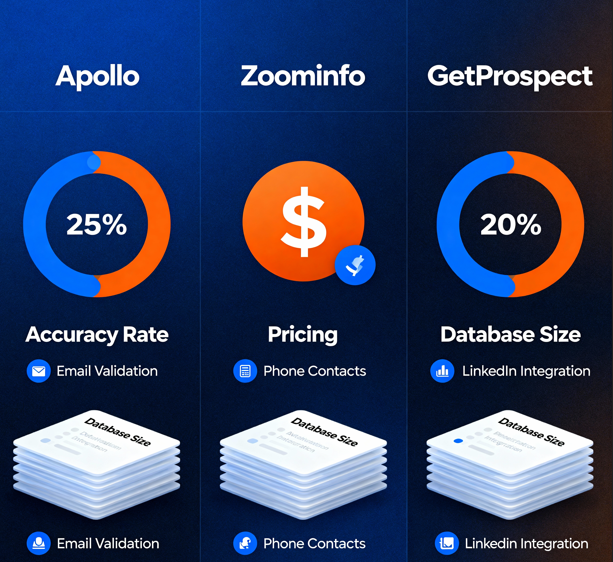I’ve been using lead generation and contact data tools for more than 11 years now, and I can tell you that choosing the wrong tool can absolutely kill your outreach campaigns before they even start. Bad email addresses mean bounces, bounces mean your sender reputation tanks, and once your sender reputation is damaged, even your good emails end up in spam folders. It’s a vicious cycle that I’ve seen destroy otherwise solid sales operations.
Over the years working as head of product and marketing operations for a Toronto based sales and marketing training company, I’ve used pretty much every major contact data tool on the market. We were managing campaigns for Fortune 500 tech companies, so data accuracy wasn’t just nice to have, it was absolutely critical. One bad campaign with 30% bounce rates could damage a client’s domain reputation for months.
Today I’m going to break down the three tools I’ve used most extensively, Apollo, Zoominfo, and GetProspect, and tell you exactly which one is worth your money based on real world usage, not just what their marketing pages promise.
My Testing Methodology and What Actually Matters
Before I dive into each tool, let me explain how I actually tested these platforms because there’s a lot of BS reviews out there written by people who’ve never actually run a serious outreach campaign in their lives.
For this comparison, I pulled the same list of 500 contacts across different industries and company sizes using each platform. These were real prospects that matched typical B2B SaaS ideal customer profiles, mostly VP level and above at companies with 100-5000 employees in tech, financial services, and healthcare.
Here’s what I measured that actually matters for your sales operations:
Email Accuracy Rate: What percentage of emails were valid and didn’t bounce Direct Dial Accuracy: For phone numbers, how many were actually direct lines versus switchboards Data Freshness: How current was the job title and company information Coverage: What percentage of my target accounts actually had contact data available Ease of Use: How long does it take to actually build a list and export it Integration Capabilities: How well does it work with CRMs and sales engagement platforms Cost Per Contact: What are you actually paying when you break it down
Let’s get into each tool.
Zoominfo: The Enterprise Beast That Costs a Fortune
Let me start with Zoominfo because it’s probably the most well-known and definitely the most expensive option on this list. I’ve used Zoominfo for about 8 years across multiple companies and campaigns, so I know this platform inside and out.
The Good Parts of Zoominfo
Zoominfo has the largest database, there’s no question about that. When I was building lists for enterprise level campaigns targeting Fortune 500 companies and their vendors, Zoominfo consistently had the best coverage. We’re talking 80-90% coverage for VP level and above contacts at large companies.
The data accuracy on Zoominfo is also legitimately good when you’re targeting established companies with stable leadership teams. In my testing, email accuracy rates were around 88-92%, which is pretty solid for contact data. Direct dial numbers were accurate about 75-80% of the time, though you still get plenty of switchboard numbers mixed in.
The intent data and technographics features are genuinely useful if you know how to use them properly. Being able to see that a company is actively researching your category or just removed a competitor’s technology from their stack, that’s valuable trigger based prospecting intelligence that can significantly improve your conversion rates.
The Salesforce integration is probably the most robust of any contact data tool I’ve used. If you’re running Salesforce as your CRM and you have the budget, the integration makes enrichment and data management pretty seamless.
The Problems With Zoominfo
The biggest problem with Zoominfo is the cost, and I’m not just talking about the price tag, I’m talking about the total cost of ownership. First, they don’t publish pricing, which should tell you something right there. From my experience and conversations with other users, you’re looking at minimum $15,000-20,000 per year for a single user license, and that’s on the low end. Enterprise contracts with multiple seats can easily run $100,000+ annually.
Second problem is the minimum commitment, Zoominfo typically requires annual contracts, so if you realize three months in that it’s not working for your use case, you’re stuck paying for the whole year anyway. I’ve seen small sales teams blow their entire tool budget on Zoominfo only to barely use it because the learning curve was steeper than expected.
Third issue is data accuracy drops significantly when you’re targeting smaller companies or newer startups. If you’re going after Series A and Series B companies or fast growing tech startups, Zoominfo’s data can be 6-12 months out of date. I ran a campaign targeting recently funded startups and found that almost 35% of the contacts had outdated job titles or had left the company entirely.
The platform is also bloated with features that most sales teams will never use. Yes, it’s powerful, but if you’re a small sales team or a solo consultant, you’re paying for a bunch of enterprise features you don’t need. It’s like buying an 18-wheeler truck when all you need is a pickup truck to haul some tools around.
When Zoominfo Actually Makes Sense
If you’re an enterprise sales team targeting large established companies, have budget over $20K annually for contact data, need deep technographic and intent data, and have dedicated sales ops people to manage the platform, then Zoominfo can be worth it. But for most small to mid-size sales teams, you’re probably overpaying for capabilities you’ll never fully utilize.
Apollo: The All-in-One Platform That Keeps Getting Better
Apollo is probably my most used tool over the last 5 years because it combines contact data with a sales engagement platform, which means you can find prospects and run outreach campaigns all in one place. I’ve used Apollo for everything from building targeted account lists to running full multi-touch email sequences.
What Makes Apollo Stand Out
The biggest advantage of Apollo is that it’s a complete sales engagement platform, not just a contact database. You get contact data, email sequencing, calling, LinkedIn automation, and CRM integration all in one tool. For small sales teams or solo sales professionals, this consolidation alone can save you $200-300 per month versus using separate tools for each function.
The contact database is legitimately large, Apollo claims over 275 million contacts and 73 million companies. In my real world usage, I found coverage to be pretty good for mid-market companies, typically 60-75% coverage for VP level contacts at companies with 50-2000 employees.
Email accuracy in my testing came in around 82-86%, which is slightly lower than Zoominfo but still acceptable for most campaigns. The key is you need to use Apollo’s email verification feature before sending, which will flag risky emails and improve your actual delivery rates.
The pricing is transparent and way more affordable than Zoominfo. You can get started for free with limited credits, and paid plans start around $49-79 per user per month. Even their higher tier plans are under $150 per month, which is literally 10x cheaper than Zoominfo for most use cases.
The Chrome extension is fantastic for prospecting on LinkedIn. I use it constantly when I’m browsing LinkedIn Sales Navigator to instantly grab contact information and add prospects to sequences. It saves probably 2-3 hours per week versus manually copying information.
Where Apollo Falls Short
The biggest weakness is data accuracy for senior executives at very large enterprises. If you’re trying to reach C-suite at Fortune 500 companies, Apollo’s coverage and accuracy drops noticeably compared to Zoominfo. I’d estimate accuracy for C-level at companies over 10,000 employees is maybe 65-70%.
Phone data is weaker than email data. Direct dial accuracy is probably around 60-65% in my testing, with a lot of switchboard numbers or disconnected lines mixed in. If phone outreach is a major part of your strategy, this can be frustrating.
The intent data and technographic features exist but they’re not as comprehensive as Zoominfo. You get basic technology stack information, but it’s not as detailed or current. For sophisticated trigger based prospecting strategies, you might need to supplement with other tools.
Customer support can be hit or miss. When you’re on the lower tier plans, getting responses can take 24-48 hours. For issues that are blocking your campaigns, that delay can be costly.
When Apollo Is Your Best Choice
If you’re a small to mid-size sales team targeting mid-market companies, want an all-in-one platform for prospecting and outreach, need transparent and affordable pricing under $150 per user per month, and value ease of use and speed of implementation, Apollo is probably your best option. I use it as my daily driver for most campaigns because the combination of contact data plus engagement platform just makes workflow so much more efficient.
GetProspect: The Budget-Friendly Specialist
GetProspect is the least known of these three tools, but it’s become one of my go-to solutions for specific use cases, particularly when I’m doing heavy LinkedIn prospecting. I discovered GetProspect about 4 years ago and it’s been a reliable part of my toolkit ever since.
What GetProspect Does Really Well
The LinkedIn integration is excellent. The Chrome extension works smoothly with LinkedIn Sales Navigator and regular LinkedIn, making it super easy to extract contact information while you’re browsing profiles or search results. I can build a list of 100 prospects from LinkedIn in about 15-20 minutes using GetProspect.
Email finding accuracy is actually pretty good considering the price point. In my testing, I got about 78-82% valid email addresses, which is slightly lower than Apollo but still usable for outreach. The key is they’re very transparent about confidence scores, so you can filter for only high-confidence emails.
The pricing is incredibly affordable. Plans start at around $49 per month for 1,000 credits, and they offer a free plan with 50 credits per month. For freelancers, consultants, or small sales teams just getting started, this low barrier to entry makes it accessible.
Bulk processing is straightforward. You can upload a CSV of LinkedIn profile URLs and GetProspect will find contact information for the entire list. I’ve used this feature to process lists of 500-1000 prospects that I built in Sales Navigator using advanced Boolean operators.
The API access is available even on lower tier plans, which is great if you want to build custom workflows or integrate with your existing sales stack.
The Limitations of GetProspect
The database size is significantly smaller than Apollo or Zoominfo. GetProspect is primarily finding emails in real-time rather than pulling from a massive pre-built database. This means coverage can be spotty, especially for executives at larger companies who guard their contact information carefully.
Phone data is basically non-existent. If you need direct dial numbers, GetProspect won’t help you. It’s really focused on email finding, so if phone outreach is important for your strategy, you’ll need a different tool.
There’s no built-in outreach platform. Unlike Apollo, GetProspect is just for finding contact information. You’ll need to use it alongside a separate sales engagement platform like Salesloft, Mailshake, or even Apollo for the outreach component.
The company and firmographic data is limited. You get basic information but nothing like the deep technographics, intent signals, or detailed company profiles you get with Zoominfo or even Apollo.
When GetProspect Makes Sense
If you’re primarily prospecting through LinkedIn Sales Navigator, operating on a tight budget under $100 per month, focused mainly on email outreach rather than phone, and willing to use multiple tools in your stack, GetProspect can be a smart choice. I often use it as a supplement to Apollo, using GetProspect for LinkedIn-heavy campaigns and Apollo for everything else.
My Real World Recommendation Based on Different Scenarios
After using all three tools extensively across hundreds of campaigns and thousands of prospects, here’s what I actually recommend based on your specific situation.
If you’re a solo consultant or freelancer: Start with GetProspect for LinkedIn prospecting and use the free or low-tier Apollo plan for everything else. Total cost under $100 per month and you’ll have everything you need to run effective campaigns.
If you’re a small sales team (2-5 SDRs): Go with Apollo. The all-in-one nature of the platform will save you time and money versus stitching together multiple tools. Budget around $100-150 per user per month.
If you’re targeting mid-market companies ($50M-500M revenue): Apollo is your best bet. The data coverage and accuracy is strong for this segment and the price-to-value ratio is excellent.
If you’re enterprise sales targeting Fortune 500 companies: Bite the bullet and get Zoominfo if you have the budget. The data coverage and accuracy for large enterprise is legitimately better, and the intent data can drive significant ROI if you use it properly.
If you’re a high-growth startup with both mid-market and enterprise targets: Start with Apollo and add Zoominfo for your enterprise accounts only. Use Apollo for your day-to-day prospecting and reserve Zoominfo credits for your highest value target accounts.
The Data Enrichment Strategy I Actually Use
Here’s my honest answer about what I do in my own sales operations and what I recommend to clients. I don’t rely on just one tool because each has strengths and weaknesses.
My typical workflow looks like this:
- Build targeted account lists in LinkedIn Sales Navigator using Boolean operators and triggered searches
- Export those prospects and run them through Apollo first since it’s the most cost-effective
- For any contacts where Apollo doesn’t find email or has low confidence scores, I run them through GetProspect
- For enterprise target accounts over $1B in revenue, I use Zoominfo to get the most accurate data and direct dial numbers
- Before any outreach campaign, I run email validation through Apollo or a dedicated validation tool like NeverBounce to catch any remaining bad emails
This multi-tool approach might sound complicated but it actually saves money and improves results. I’m not paying for Zoominfo for every single contact when Apollo can handle 70-80% of my needs at a fraction of the cost.
The Bottom Line on Contact Data Tools
Look, there’s no perfect contact data tool that’s going to give you 100% accurate information 100% of the time. The B2B contact data market is inherently messy because people change jobs, companies get acquired, email addresses change, and privacy regulations keep tightening.
What matters is choosing the tool that fits your budget, matches your target market, and integrates well with your existing sales stack. For most sales teams reading this blog, that tool is probably Apollo because of the combination of good-enough data accuracy, affordable pricing, and all-in-one platform capabilities.
But if you’re going after enterprise accounts and have the budget, Zoominfo’s superior data coverage is worth the premium. And if you’re bootstrapping or doing heavy LinkedIn prospecting, GetProspect can be a smart addition to your toolkit.
The most important thing is to actually test these tools with your specific target market before committing to annual contracts. Most of them offer free trials or low-cost starter plans, use those to validate data accuracy for your particular use case before spending thousands of dollars.
And remember, even the best contact data is worthless if your messaging sucks or you’re reaching out at the wrong time. Focus on trigger based prospecting strategies, write compelling outreach messages, and follow up consistently. The tools just make the process more efficient, they don’t replace the fundamentals of good sales execution.




